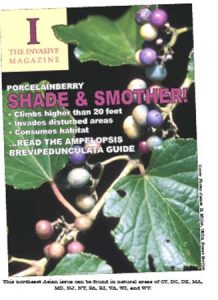In this exercise, developed by Marjorie Porter of the Somers, Connecticut, school system, students assemble information on non-native plant species, investigating how they have increased in frequency in Connecticut and why they are ecologically important. A pdf version of this exercise is available to download here.
PART I: Exotic Invaders
According to the National Park Service (undated, pdf here), “Weeds Gone Wild” are species that:
- Have invaded natural habitat
- Have been introduced to new areas outside of their native ranges
- Are also referred to as “alien”, “exotic”, “non-native”, and “non-indigenous”
- Are able to crowd out native species when introduced to new habitats
- Are capable of reproducing and spreading rapidly because they are free from the natural controls present in their native lands
Discuss the following questions with your team and be prepared to present to the class:
- How would an invasive plant species get to Connecticut in the first place?
- How would an invasive plant interfere with the existing ecosystem? In other words, what problems could it cause?
-
- Give two examples that support your ideas
- What factors do you think might allow an invasive plant species to push out other plant species? What characteristics of the invasive plant and/or the existing ecosystem could allow this to happen?
- Visit the National Park Service’s “Invasive & Non-Native Species” Web site to better understand the problem of “invasives”: https://www.nps.gov/subjects/invasive/index.htm
-
- Select “About” to check your responses to items 1, 2 & 3 above.
-
- Make additions or edits to those items as necessary using a different colored writing utensil!
PART II: An Invader of Your Own
- Visit the USDA Plants Database (http://plants.usda.gov/) to identify and describe a specific invasive plant species found in Connecticut. Look at the right-hand margin and select, “Learn about noxious and invasive plants.”
- The select, “State Noxious Weed Lists” and then select, “Connecticut”
- Browse the species list and select an invasive plant species to investigate. Click on the scientific name to find out more about it!
- Double-check with your teacher – make sure that the plant species you have selected is a good choice and that no other student has chosen the same one. Here is a list of invasive species in Connecticut for which the UConn herbarium has the largest number of specimens (this will become important later).
- Identify and summarize the characteristics that are unique to your invasive plant species and download two or three photographs of the plant.
- Remember to save/record all URLs and references!
- Organize a “Magazine Cover” (using the rubric and samples provided as guides.) The cover must contain the following components:
-
- Accurate information about the invasive species
- All references organized in a bibliography
- Four creative and informational magazine “story” summaries
- At least one photograph of your alien species
- Creative titles and “story” summaries
- Organized and attractive (i.e. professionally done) features on the cover
- Correct spelling & grammar
- Evidence that the information was translated from the original sources and was well-understood.
Examples of covers done by others:
PART III: The First Date!
- Go to: https://biodiversity.uconn.edu/herbarium-database/
- Select “Herbarium Database”
- Select “Click Here to go to Advanced Search”
- Carry out a query for your selected alien species: type in the genus and species, then click the box next to “Restrict search to Connecticut specimens only” and “Submit”
- Note: Use its SCIENTIFIC name!
- Click on the hotlink for “Map these results in Berkeley Mapper”
- If your map isn’t already zoomed on Connecticut, do so by double-clicking on the state.
- Click on the “Draw a shape” button at the top of the map, then use your mouse to draw a polygon around all the points on your map. Once your polygon is complete, it will turn purple and you can click on “Query Points Inside.”
By doing this you can view ALL of the records for your plant that are on the map (you can drag the gray bar between the map and the table up to see more records). Make sure that you only record the information for those that are in Connecticut.
- Click on the Year column heading, which will sort your specimens from earliest to latest
- Use any graphing program to graph how the number of specimens has changed over time, using the following divisions for years: “Before 1900” “1900 to 1950” “1950 to Present”
-
- What was the earliest date (year) showing a record of your alien plant species in Connecticut? _____________
-
- Is it possible that your plant species was present in CT before that date? Explain your answer!
- What trend, if any, exists with regard to the number of plants identified in each year category? (Be sure to refer to the data!)
- Post your graph on the wall alongside those of your peers. Which invasive species had the greatest numbers in the period “Before 1900”?
- Which invasive species had the greatest numbers during the period “1950 to Present“?
- There are many reasons for the differences that you noted in the two previous questions. Identify and carefully explain why some species are more represented in one time category than in another.
- Develop two new questions about your chosen invasive species that could probably be answered using a mapping program.


